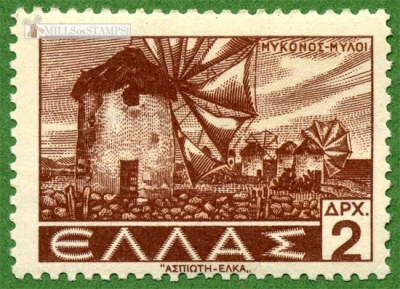-
Definitive issue. Landshafts
Greece 1942.12.01
In issue: Stamp(s): 2
-
Number by catalogue: Michel: 464 Yvert: 462 Scott: 437
Perforation type: 12 ½x12 ½
Subject:
2 drahmes. The windmills on Mykonos*
Additional:
*Mykonos (Greek Μύκονος) - an island in the Cyclades archipelago. Located between the neighboring islands of Tinos, Syros, Paros and Naxos, it is washed by the waters of the Aegean Sea. Area - 85 km². The administrative center is the city of Mykonos.
There are no outstanding cliffs and mountains on the island, mainly it is covered with low hills, on which many settlements are located.
The main areas of the economy: fishing, construction and tourism (including lgbt and sex tourism).
Like most places in Greece, ancient legends are associated with Mykonos. The island is named after the hero of Mikon, the grandson of Apollo. There was a battle of gods and titans, the bodies of the legendary giants defeated by Hercules turned into the rocks of Mykonos.
The mills of the island and the main city of Mykonos are perhaps their main attraction.
All roads lead to them - because they are located on the highest urban point of the Chora, visible from almost anywhere in the city, from rocky plains, hills, from the bay, already on the way to the island.
The island's successful geographical location on the Europe-Asia trade route allowed the Venetians to establish a large-scale grain processing business in these parts. The climate of the island and the strong gusty wind characteristic of this region contributed to this. During the construction of the mills, many different points were taken into account. As a rule, mills were built on high hills, on capes or on spacious plains so as not to create obstacles to the wind. They also took into account the distance to the nearest settlements, which should have been small enough to use pack animals for transporting grain and flour. However, no other structures were built near the mills. A prerequisite was the proximity to the harbor.
The mills are huge, white, round-shaped towers with a sharp thatched roof and very small windows. Very quickly, mills became an important source of income for local residents and had a significant impact on the economic development of the island. Most of these magnificent structures were built by the Venetians in the 16th century, although they were built until the beginning of the 20th century.
Gradually, with the development of technological progress, the use of windmills and their number decreased until in the middle of the 20th century they completely stopped their work. Over time, most mills have been carefully renovated. Today, 16 windmills have been preserved on the island of Mykonos. Some of them (specifically - 6) are located on the famous hill in the Chora. They have cafes, museums, exhibition halls and hotels.
Topics: Windmills


